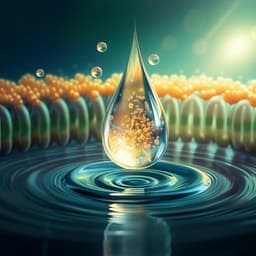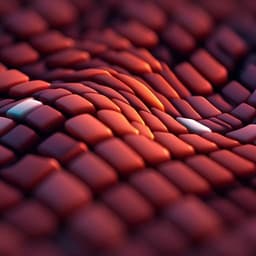
Environmental Studies and Forestry
Multifunctional solar water harvester with high transport selectivity and fouling rejection capacity
X. Hao, H. Yao, et al.
Discover a revolutionary solar-powered graphene/alginate hydrogel that excels in clean water extraction while rejecting harmful pollutants. This innovative material not only filters out over 99.5% of volatile organic compounds but also deactivates nearly 100% of bacteria, making it a game-changer for providing safe drinking water. This pioneering research was conducted by Xuanzhang Hao, Houze Yao, Panpan Zhang, Qihua Liao, Kaixuan Zhu, Jian Chang, Huhu Cheng, Jiayin Yuan, and Liangti Qu.
~3 min • Beginner • English
Introduction
Surface waters are increasingly contaminated by industrial emissions, including waste oils, volatile organic compounds (VOCs), heavy metal ions and microorganisms. At the same time, the global shortage of clean water is severe, with one in three people lacking access to safe drinking water. Conventional purification technologies such as thermal distillation and membrane-based reverse osmosis can remove contaminants but suffer from high energy consumption, complex processes, economic burdens and secondary pollution. Solar-powered interfacial water production is a green, decentralized strategy that leverages renewable sunlight and has achieved high sunlight utilization and rapid vapor generation with materials like graphene, polypyrrole and metal nanoparticles. However, when water contains complex contaminants, current single-function solar systems cannot guarantee clean, safe output. VOCs can be readily transported with bulk water to the evaporation surface; non-volatile organics (often oils) foul porous structures; and bacteria adhere and proliferate on surfaces, all leading to performance loss. To overcome these barriers, the authors propose a graphene/alginate hydrogel (GAH) with a hyper-dense internal network and bio-inspired surface engineering designed for selective water transport and robust antifouling in complex waters.
Literature Review
Prior solar interfacial evaporators using photothermal materials (graphene, polypyrrole, metal nanoparticles) demonstrated high solar absorption and efficient vapor generation, yet typically rely on capillary-driven bulk water transport that can co-carry VOCs to the interface. Traditional desalination/purification (thermal distillation, reverse osmosis) is effective but energy- and cost-intensive with waste and secondary pollution concerns. Hydrogel-based and porous photothermal systems have shown promise for enhanced evaporation and some salt rejection via structural designs or osmotic effects, but often remain vulnerable to VOC crossover, oil fouling, bacterial adhesion, and salt crystallization during prolonged operation. Graphene-based assemblies can offer strong photothermal conversion and antimicrobial properties, while polyelectrolyte hydrogels can provide osmotic pumping and ion exclusion. Bio-inspired micro/nano-structured surfaces (e.g., fish-scale-like) can impart underwater superoleophobicity to mitigate oil adhesion. Building on these insights, a multifunctional design integrating bound-water transport, high osmotic pressure networks, and micro-nanostructured surfaces is positioned to address the multi-contaminant challenge.
Methodology
Material preparation: Graphene oxide (GO) suspension was synthesized using a modified Hummers method, including oxidation of graphite in concentrated sulfuric acid with KMnO4, sequential dilution and oxidation quenching with H2O2, filtration and HCl washing, dispersion and removal of unexfoliated graphite by centrifugation, and dialysis to remove residual ions. For GAH fabrication, a sodium alginate solution (2 wt.%) was mixed with GO dispersion, degassed by centrifugation, cast and dried to form a membrane. The membrane underwent multiple ionic cross-linking cycles with AlCl3, combined with stressing and drying, followed by chemical reduction to convert GO to rGO and densify the rGO/alginate network. Direct-laser writing printed a fish-scale-inspired micro-nano multi-scale pattern on both surfaces.
Characterization: Morphology was examined by SEM to confirm a densely packed laminar cross-section and surface stripes with exposed rGO nanosheets (average stripe width ~45 ± 10 μm, spacing ~100 ± 10 μm). Optical absorption (UV–Vis–NIR) quantified solar-spectrum absorption; patterned GAH showed ~95% absorbance. Wettability was evaluated by water droplet spreading (contact angle approaching 0° along stripes) and underwater oil contact angles with various oils/solvents. Mechanical properties (tensile strength) and saturated water content (Cw = Qs/(Qs−Qd)) were measured for GAH-x (x cross-linking cycles) to assess densification. Differential scanning calorimetry (DSC) from −70 to 30 °C probed water states; the disappearance of endothermic peak near 0 °C indicated elimination of bulk/freezable water in higher-cycle samples.
Performance tests: Solar vapor generation was measured under one standard sunlight (1 sun) using a lab setup, including a sealed collector system for purity assessment; a 3D device configuration achieved 2.51 kg m−2 h−1 with ~82.6% efficiency (Supplementary). VOC removal was tested for toluene, dichloroethane (EDC) and dioxane (initial ~100 ppm) and phenol, analyzing concentrations in raw sewage vs. condensed water. Non-volatile organic compound (NOC) removal was evaluated using dyes (methyl red, methylene blue and mixtures) by UV–Vis spectroscopy and visual observation. Ion rejection for K+, Ca2+, Na+, Mg2+ was evaluated using 1.5 wt.% single-salt solutions; concentrations in the extracted water were quantified (ICP or equivalent). Bacteria removal in produced water was assessed via regrowth assays: domestic river water vs. GAH-extracted water incubated at 37 °C for 48 h on growth media. Surface antibiosis was tested by contacting raw sewage with GAH surface, then assessing survival relative to a control treated identically without GAH; SEM observed bacterial integrity. Salt rejection and anti-fouling were assessed by equilibrating GAH in NaCl solutions across concentrations to calculate rejection rate (REJ), and by long-term cycle tests: 5 days under simulated solar conditions (750 W m−2, 12 h light/12 h dark) extracting from seawater, monitoring internal salt mass fraction Wm after light and dark periods, structural integrity, water extraction rate, and ion rejection maintenance. High-salinity test included 17 wt.% NaCl solution under 1 sun for 20 h to check visible salt crystallization.
Key Findings
- GAH enables highly selective water transport with broad-spectrum contaminant rejection: >99.5% removal of VOCs (toluene, dichloroethane, dioxane; reduced from ~100 ppm to <0.07 ppm) and phenol; >99.3% rejection of common ions (K+, Ca2+, Na+, Mg2+) from 1.5 wt.% salt solutions to <100 ppm; 100% removal of non-volatile organics (dye signals absent) and bacteria (no colonies in regrowth tests).
- Solar performance: Patterned GAH absorbs ~95% across the solar spectrum and heats efficiently, achieving a vapor generation rate up to 2.51 kg m−2 h−1 in a 3D device with ~82.6% efficiency (Supplementary data).
- Water state control: Multiple Al3+-induced cross-linking cycles densify the rGO/alginate network (saturated water content Cw reduced from 61.3% in GAH-1 to 13.1% in GAH-4). DSC shows elimination of freezable bulk water in higher-cycle GAH (GAH-3/4), supporting bound-water-dominated transport that impedes VOC co-transport.
- Anti-oil-fouling: Underwater oil contact angles on GAH exceed 140° for common oils/solvents (e.g., soybean oil ~143°, toluene 143°, n-hexane 152°, benzene 141°, petroleum ether 159°, hexamethylene 144°), indicating superoleophobicity and low adhesion due to the hydrophilic fish-scale-like micro-nanostructure (Cassie state).
- Antibiosis: The rGO-rich patterned surface deactivates bacteria on contact, with <1% survival vs. control (78% survival), and SEM revealing disrupted cells, confirming near-complete surface antibacterial efficacy.
- Salt rejection and fouling resistance: Calculated NaCl rejection ~94.9% at 3.6 wt.%; ~24% even near saturation (~25 wt.% NaCl) indicating very high internal osmotic pressure. During 5-day cyclic operation (12 h light/12 h dark) on seawater at 750 W m−2, internal salt mass fraction Wm remained low and stable (~0.25 wt.% after light, refreshing to ~0.18 wt.% after dark), preventing crystallization; ion rejection capacity maintained at ~99.8% of initial and water extraction rate and surface structure remained stable. No salt fouling after 20 h under 1 sun in 17 wt.% NaCl solution.
- Surface hydrophilicity: Water droplets rapidly spread along surface stripes to a contact angle of ~0°, enhancing water management and solar-thermal conversion.
Discussion
The GAH design addresses contamination challenges in solar water harvesting by eliminating bulk capillary water and promoting bound-water transport within a hyper-dense, cross-linked rGO/alginate network. Strong hydrogen bonding between water molecules and the polymer network enables water uptake and transport while VOCs, with weaker dipole–dipole or hydrogen-bonding interactions with the matrix, are disfavored, dramatically reducing their crossover into the vapor. The polyelectrolyte-rich, densely ionized network produces high internal osmotic pressure, effectively excluding ions and minimizing salt uptake, which prevents salt accumulation and crystallization under continuous operation. The fish-scale-inspired micro-nanostructured surface increases solar absorption via light trapping, enhances hydrophilicity for rapid water spreading, imparts underwater superoleophobicity to reject oil adhesion, and exposes rGO nanosheets that are intrinsically antibacterial. Collectively, these mechanisms yield a multifunctional, robust evaporator capable of purifying complex surface waters in a single, solar-driven step, coupling high flux with stringent contaminant rejection and durable antifouling behavior, thereby advancing practical, low-carbon water purification solutions.
Conclusion
A graphene/alginate hydrogel (GAH) solar-powered extractor was developed that unifies selective bound-water transport with bio-inspired surface engineering to produce clean water from complexly contaminated sources. The device exhibits high-efficiency solar-thermal conversion (>95% solar absorption; surface temperatures up to ~80 °C under 1 sun as reported), and rejects contaminants broadly: >99.5% VOCs, >99.3% common ions (K+, Ca2+, Na+, Mg2+), and complete removal of NOCs and bacteria. Its patterned, hydrophilic, fish-scale-like surface confers underwater superoleophobicity (oil contact angles >140°) and near-100% surface antibiosis via exposed rGO nanosheets, while a highly osmotic internal network prevents salt crystallization (e.g., ~94.9% NaCl rejection at 3.6 wt.% and stable operation in cyclic tests without fouling). These results highlight a practical route for decentralized, low-carbon water purification in polluted hydrological environments. Future research could focus on scaling fabrication (roll-to-roll laser patterning), long-term field trials across diverse waters, optimization of cross-link density for flux-selectivity balance, and integration into modular systems for off-grid water supply.
Limitations
Related Publications
Explore these studies to deepen your understanding of the subject.







